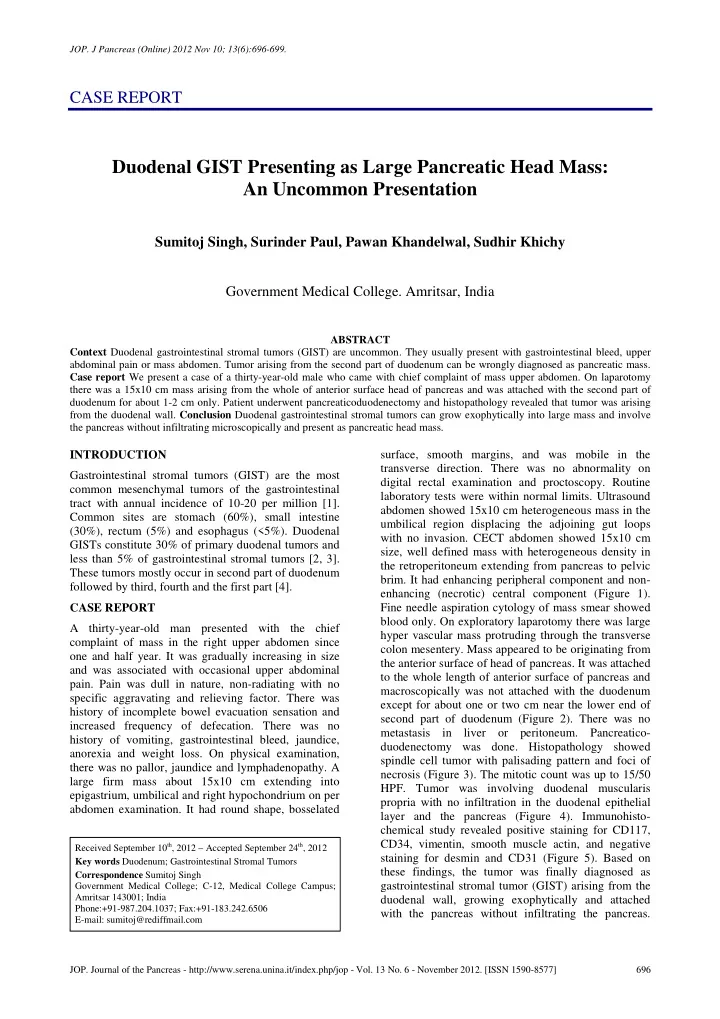

JOP. J Pancreas (Online) 2012 Nov 10; 13(6):696-699. CASE REPORT Duodenal GIST Presenting as Large Pancreatic Head Mass: An Uncommon Presentation Sumitoj Singh, Surinder Paul, Pawan Khandelwal, Sudhir Khichy Government Medical College. Amritsar, India ABSTRACT Context Duodenal gastrointestinal stromal tumors (GIST) are uncommon. They usually present with gastrointestinal bleed, upper abdominal pain or mass abdomen. Tumor arising from the second part of duodenum can be wrongly diagnosed as pancreatic mass. Case report We present a case of a thirty-year-old male who came with chief complaint of mass upper abdomen. On laparotomy there was a 15x10 cm mass arising from the whole of anterior surface head of pancreas and was attached with the second part of duodenum for about 1-2 cm only. Patient underwent pancreaticoduodenectomy and histopathology revealed that tumor was arising from the duodenal wall. Conclusion Duodenal gastrointestinal stromal tumors can grow exophytically into large mass and involve the pancreas without infiltrating microscopically and present as pancreatic head mass. INTRODUCTION surface, smooth margins, and was mobile in the transverse direction. There was no abnormality on Gastrointestinal stromal tumors (GIST) are the most digital rectal examination and proctoscopy. Routine common mesenchymal tumors of the gastrointestinal laboratory tests were within normal limits. Ultrasound tract with annual incidence of 10-20 per million [1]. abdomen showed 15x10 cm heterogeneous mass in the Common sites are stomach (60%), small intestine umbilical region displacing the adjoining gut loops (30%), rectum (5%) and esophagus (<5%). Duodenal with no invasion. CECT abdomen showed 15x10 cm GISTs constitute 30% of primary duodenal tumors and size, well defined mass with heterogeneous density in less than 5% of gastrointestinal stromal tumors [2, 3]. the retroperitoneum extending from pancreas to pelvic These tumors mostly occur in second part of duodenum brim. It had enhancing peripheral component and non- followed by third, fourth and the first part [4]. enhancing (necrotic) central component (Figure 1). CASE REPORT Fine needle aspiration cytology of mass smear showed blood only. On exploratory laparotomy there was large A thirty-year-old man presented with the chief hyper vascular mass protruding through the transverse complaint of mass in the right upper abdomen since colon mesentery. Mass appeared to be originating from one and half year. It was gradually increasing in size the anterior surface of head of pancreas. It was attached and was associated with occasional upper abdominal to the whole length of anterior surface of pancreas and pain. Pain was dull in nature, non-radiating with no macroscopically was not attached with the duodenum specific aggravating and relieving factor. There was except for about one or two cm near the lower end of history of incomplete bowel evacuation sensation and second part of duodenum (Figure 2). There was no increased frequency of defecation. There was no metastasis in liver or peritoneum. Pancreatico- history of vomiting, gastrointestinal bleed, jaundice, duodenectomy was done. Histopathology showed anorexia and weight loss. On physical examination, spindle cell tumor with palisading pattern and foci of there was no pallor, jaundice and lymphadenopathy. A necrosis (Figure 3). The mitotic count was up to 15/50 large firm mass about 15x10 cm extending into HPF. Tumor was involving duodenal muscularis epigastrium, umbilical and right hypochondrium on per propria with no infiltration in the duodenal epithelial abdomen examination. It had round shape, bosselated layer and the pancreas (Figure 4). Immunohisto- chemical study revealed positive staining for CD117, CD34, vimentin, smooth muscle actin, and negative Received September 10 th , 2012 – Accepted September 24 th , 2012 staining for desmin and CD31 (Figure 5). Based on Key words Duodenum; Gastrointestinal Stromal Tumors these findings, the tumor was finally diagnosed as Correspondence Sumitoj Singh gastrointestinal stromal tumor (GIST) arising from the Government Medical College; C-12, Medical College Campus; Amritsar 143001; India duodenal wall, growing exophytically and attached Phone:+91-987.204.1037; Fax:+91-183.242.6506 with the pancreas without infiltrating the pancreas. E-mail: sumitoj@rediffmail.com JOP. Journal of the Pancreas - http://www.serena.unina.it/index.php/jop - Vol. 13 No. 6 - November 2012. [ISSN 1590-8577] 696
JOP. J Pancreas (Online) 2012 Nov 10; 13(6):696-699. Figure 3. Histopathology showing spindle shaped tumor arranged in palisading pattern (H&E stain, 200x). DISCUSSION Gastrointestinal stromal tumor (GIST) arises from the interstitial cells of Cajal which are located in the submucosal and myentric plexus of gastrointestinal tract. The main mechanism in the pathogenesis of most GISTs is the mutation in one of two receptor tyrosine kinase genes (KIT and PDGFRA). On immunohisto- chemical staining, 95% are CD117 positive, 70% are CD34, and 40% stains positive for smooth muscle actin [5, 6]. They are typically negative for desmin and S- 100 (<5% positive) [5]. There are three main Figure 1. Contrast enhanced computed tomography showing: a. heterogeneous mass arising from pancreas; b. A 15x10 cm histological cell types of GIST: spindle cell type (most heterogeneous mass with peripheral enhancement and central common), epithelioid cell type, and the mixed spindle- necrosis. epithelioid type [5]. In our case tumor was of spindle type and stained positive for CD117, CD34 and Post-operatively patient had biliary leak which was negative for desmin. The mean age of patients with managed conservatively and discharged in satisfactory GIST is 53 years and only about the 5% of GIST condition with the advice to take imatinib 400 mg patients are younger than 30 years [4]. In our case age daily. of patient was 30 years, which is unusual for GIST. Duodenal GIST majority of times presents with gastrointestinal bleeding, epigastric pain, palpable mass and intestinal obstruction [4, 7]. Microscopic mucosal Figure 2. Macroscopic appearance of resected specimens showing Figure 4. Histopathology showing tumor involving the duodenal tumor attached mainly along the pancreatic head and with duodenum only near the lower end of second part of duodenum. wall (H&E stain, 40x). JOP. Journal of the Pancreas - http://www.serena.unina.it/index.php/jop - Vol. 13 No. 6 - November 2012. [ISSN 1590-8577] 697
Recommend
More recommend